Validation and Spatiotemporal Analysis of Surface Net Radiation from CRA/Land and ERA5-Land over the Tibetan Plateau
Abstract
:1. Introduction
2. Materials and Methods
2.1. In Situ Observation Data
2.2. Reanalysis Data
2.3. Methods for Validation
3. Results
3.1. Validation of the CRA/Land and ERA5-Land RN Data
3.1.1. Validation Results at the Daily Scale
3.1.2. Validation Results at the Monthly Scale
3.2. Spatiotemporal Analysis
4. Discussion
5. Conclusions
Author Contributions
Funding
Institutional Review Board Statement
Informed Consent Statement
Data Availability Statement
Acknowledgments
Conflicts of Interest
Abbreviations
| RN | Surface Net Radiation |
| TP | Tibetan Plateau |
| CRA/Land | China Meteorological Administration Global Land Surface Reanalysis Products |
| ECMWF | European Centre for Medium-Range Weather Forecasts |
| ERA5-Land | ECMWF Land Surface Reanalysis version 5 |
| DSR | Downwelling Shortwave Radiation |
| USR | Upwelling Shortwave Radiation |
| DLR | Downwelling Longwave Radiation |
| ULR | Upwelling Longwave Radiation |
| SRN | Net Downward Shortwave Radiation |
| LRN | Net Downward Longwave Radiation |
| CC | Correlation Coefficient |
| RB | Relative Bias |
| RMSE | Root Mean Squared Error |
| LSM | Land Surface Model |
References
- Liang, S.; Wang, D.; He, T.; Yu, Y. Remote sensing of earth’s energy budget: Synthesis and review. Int. J. Digit. Earth 2019, 12, 737–780. [Google Scholar] [CrossRef]
- Jia, A.; Jiang, B.; Liang, S.; Zhang, X.; Ma, H. Validation and spatiotemporal analysis of CERES surface net radiation product. Remote Sens. 2016, 8, 90. [Google Scholar] [CrossRef]
- Wu, B.; Liu, S.; Zhu, W.; Yan, N.; Xing, Q.; Tan, S. An improved approach for estimating daily net radiation over the Heihe River Basin. Sensors 2017, 17, 86. [Google Scholar] [CrossRef]
- Mendes, K.R.; Campos, S.; Mutti, P.R.; Ferreira, R.R.; Ramos, T.M.; Marques, T.V.; dos Reis, J.S.; de Lima Vieira, M.M.; Silva, A.C.N.; Oliveira, C.P.; et al. Assessment of SITE for CO2 and Energy Fluxes Simulations in a Seasonally Dry Tropical Forest (Caatinga Ecosystem). Forests 2021, 12, 86. [Google Scholar] [CrossRef]
- Munkhjargal, M.; Menzel, L. Estimating daily average net radiation in Northern Mongolia. Geogr. Ann. A 2019, 101, 177–194. [Google Scholar] [CrossRef]
- Zhang, F.; Li, H.; Wang, W.; Li, Y.; Lin, L.; Guo, X.; Du, Y.; Li, Q.; Yang, Y.; Cao, G.; et al. Net radiation rather than surface moisture limits evapotranspiration over a humid alpine meadow on the northeastern Qinghai-Tibetan Plateau. Ecohydrology 2018, 11, e1925. [Google Scholar] [CrossRef]
- Yan, Y.; Tang, J.; Wang, S.; Niu, X.; Wang, L. Uncertainty of land surface model and land use data on WRF model simulations over China. Clim. Dynam. 2021, 57, 1833–1851. [Google Scholar] [CrossRef]
- Yang, K.; Chen, Y.Y.; Qin, J. Some practical notes on the land surface modeling in the Tibetan Plateau. Hydrol. Earth Syst. Sci. 2009, 13, 687–701. [Google Scholar] [CrossRef]
- Bisht, G.; Bras, R.L. Estimation of net radiation from the MODIS data under all sky conditions: Southern Great Plains case study. Remote Sens. Environ. 2010, 114, 1522–1534. [Google Scholar] [CrossRef]
- Jia, A.; Liang, S.; Jiang, B.; Zhang, X.; Wang, G. Comprehensive assessment of global surface net radiation products and uncertainty analysis. J. Geophys. Res.-Atmos. 2018, 123, 1970–1989. [Google Scholar] [CrossRef]
- Kim, H.Y.; Liang, S. Development of a hybrid method for estimating land surface shortwave net radiation from MODIS data. Remote Sens. Environ. 2010, 114, 2393–2402. [Google Scholar] [CrossRef]
- Liang, S.; Wang, K.; Zhang, X.; Wild, M. Review on estimation of land surface radiation and energy budgets from ground measurement, remote sensing and model simulations. IEEE. J-STARS 2010, 3, 225–240. [Google Scholar] [CrossRef]
- Liang, S.; Cheng, J.; Jia, K.; Jiang, B.; Liu, Q.; Xiao, Z.; Yao, J.; Yuan, W.; Zhang, X.; Zhao, X.; et al. The global land surface satellite (GLASS) product suite. Bull. Am. Meteorol. Soc. 2021, 102, E323–E337. [Google Scholar] [CrossRef]
- Myeni, L.; Moeletsi, M.E.; Clulow, A.D. Assessment of three models for estimating daily net radiation in southern Africa. Agric. Water. Manag. 2020, 229, 105951. [Google Scholar] [CrossRef]
- Muñoz-Sabater, J.; Dutra, E.; Agustí-Panareda, A.; Albergel, C.; Arduini, G.; Balsamo, G.; Boussetta, S.; Choulga, M.; Harrigan, S.; Hersbach, H.; et al. ERA5-Land: A state-of-the-art global reanalysis dataset for land applications. Earth. Syst. Sci. Data 2021, 13, 4349–4383. [Google Scholar] [CrossRef]
- Popov, Z.; Nagy, Z.; Baranka, G.; Weidinger, T. Assessments of Solar, Thermal and Net Irradiance from Simple Solar Geometry and Routine Meteorological Measurements in the Pannonian Basin. Atmosphere 2021, 12, 935. [Google Scholar] [CrossRef]
- Chen, J.; He, T.; Jiang, B.; Liang, S. Estimation of all-sky all-wave daily net radiation at high latitudes from MODIS data. Remote Sens. Environ. 2020, 245, 111842. [Google Scholar] [CrossRef]
- Mira, M.; Olioso, A.; Gallego-Elvira, B.; Courault, D.; Garrigues, S.; Marloie, O.; Hagolle, O.; Guillevic, P.; Boulet, G. Uncertainty assessment of surface net radiation derived from Landsat images. Remote Sens. Environ. 2016, 175, 251–270. [Google Scholar] [CrossRef]
- Marques, H.O.; Biudes, M.S.; Pavão, V.M.; Machado, N.G.; Querino, C.A.S.; Danelichen, V.H.M. Estimated net radiation in an Amazon–Cerrado transition forest by Landsat 5 TM. J. Appl. Remote Sens. 2017, 11, 046020. [Google Scholar] [CrossRef]
- Ramírez-Cuesta, J.M.; Vanella, D.; Consoli, S.; Motisi, A.; Minacapilli, M. A satellite stand-alone procedure for deriving net radiation by using SEVIRI and MODIS products. Int. J. Appl. Earth Obs. Geoinf. 2018, 73, 786–799. [Google Scholar] [CrossRef]
- Verma, M.; Fisher, J.B.; Mallick, K.; Ryu, Y.; Kobayashi, H.; Guillaume, A.; Moore, G.; Ramakrishnan, L.; Hemdrix, V.; Wolf, S.; et al. Global surface net-radiation at 5 km from MODIS Terra. Remote Sens. 2016, 8, 739. [Google Scholar] [CrossRef]
- Decker, M.; Brunke, M.A.; Wang, Z.; Sakaguchi, K.; Zeng, X.; Bosilovich, M.G. Evaluation of the reanalysis products from GSFC, NCEP, and ECMWF using flux tower observations. J. Clim. 2012, 25, 1916–1944. [Google Scholar] [CrossRef]
- Wang, A.; Zeng, X. Evaluation of multireanalysis products with in situ observations over the Tibetan Plateau. J. Geophys. Res-Atmos. 2012, 117, D05102. [Google Scholar] [CrossRef]
- Zhang, L.; Gao, L. Drought and Wetness Variability and the Respective Contribution of Temperature and Precipitation in the Qinghai-Tibetan Plateau. Adv. Meteorol. 2021, 2021, 7378196. [Google Scholar] [CrossRef]
- Immerzeel, W.W.; Van Beek, L.P.H.; Bierkens, M.F.P. Climate change will affect the Asian water towers. Science 2010, 328, 1382–1385. [Google Scholar] [CrossRef] [PubMed]
- Qu, B.; Zhang, Y.; Kang, S.; Sillanpää, M. Water quality in the Tibetan Plateau: Major ions and trace elements in rivers of the “Water Tower of Asia”. Sci. Total Environ. 2019, 649, 571–581. [Google Scholar] [CrossRef]
- Yang, M.; Nelson, F.E.; Shiklomanov, N.I.; Guo, D.; Wan, G. Permafrost degradation and its environmental effects on the Tibetan Plateau: A review of recent research. Earth-Sci. Rev. 2010, 103, 31–44. [Google Scholar] [CrossRef]
- Yao, T.; Thompson, L.; Yang, W.; Yu, W.; Gao, Y.; Guo, X.; Yang, X.; Duan, K.; Zhao, H.; Xu, B.; et al. Different glacier status with atmospheric circulations in Tibetan Plateau and surroundings. Nat. Clim. Chang. 2012, 2, 663–667. [Google Scholar] [CrossRef]
- Yang, J.; Huang, M.; Zhai, P. Performance of the CRA-40/Land, CMFD, and ERA-Interim datasets in reflecting changes in surface air temperature over the Tibetan Plateau. J. Meteorol. Res. 2021, 35, 663–672. [Google Scholar] [CrossRef]
- Yang, K.; Pinker, R.T.; Ma, Y.; Koike, T.; Wonsick, M.M.; Cox, S.J.; Zhang, Y.; Stackhouse, P. Evaluation of satellite estimates of downward shortwave radiation over the Tibetan Plateau. J. Geophys. Res-Atmos. 2008, 113, D17204. [Google Scholar] [CrossRef]
- Ma, J.; Li, R.; Liu, H.; Huang, Z.; Wu, T.; Hu, G.; Xiao, Y.; Zhao, L.; Du, Y.; Yang, S. The Surface Energy Budget and Its Impact on the Freeze-thaw Processes of Active Layer in Permafrost Regions of the Qinghai-Tibetan Plateau. Adv. Atmos. Sci. 2022, 39, 189–200. [Google Scholar] [CrossRef]
- Wang, S.; Niu, F.; Zhao, L.; Li, S. The thermal stability of roadbed in permafrost regions along Qinghai–Tibet Highway. Cold Reg. Sci. Technol. 2003, 37, 25–34. [Google Scholar] [CrossRef]
- Zhang, G.; Kang, S.; Fujita, K.; Huintjes, E.; Xu, J.; Yamazaki, T.; Haginoya, S.; Wei, Y.; Scherer, D.; Schneider, C.; et al. Energy and mass balance of Zhadang glacier surface, central Tibetan Plateau. J. Glaciol. 2013, 59, 137–148. [Google Scholar] [CrossRef]
- Che, T.; Hao, X.; Dai, L.; Li, H.; Huang, X.; Lin, X. Snow cover variation and its impacts over the Qinghai-Tibet Plateau. Bull. Chin. Acad. Sci. 2019, 34, 1247–1253. [Google Scholar]
- Chen, R.S.; Song, Y.X.; Kang, E.S.; Han, C.T.; Liu, J.F.; Yang, Y.; Qing, W.W.; Liu, Z.W. A cryosphere-hydrology observation system in a small alpine watershed in the Qilian Mountains of China and its meteorological gradient. Arct. Antarct. Alp. Res. 2014, 46, 505–523. [Google Scholar] [CrossRef]
- Han, C.; Chen, R.; Liu, Z.; Yang, Y.; Liu, J.; Song, Y.; Wang, L.; Liu, G.; Guo, S.; Wang, X. Cryospheric hydrometeorology observation in the Hulu catchment (CHOICE), Qilian Mountains, China. Vadose Zone J. 2018, 17, 1–18. [Google Scholar] [CrossRef]
- Li, X.; Yang, X.; Ma, Y.; Hu, G.; Hu, X.; Wu, X.; Wang, P.; Huang, Y.; Cui, B.; Wei, J. Qinghai lake basin critical zone observatory on the Qinghai-Tibet Plateau. Vadose Zone J. 2018, 17, 1–11. [Google Scholar] [CrossRef]
- Ma, Y.; Hu, Z.; Xie, Z.; Ma, W.; Wang, B.; Chen, X.; Li, M.; Zhong, L.; Sun, F.; Gu, L.; et al. A long-term (2005–2016) dataset of hourly integrated land–atmosphere interaction observations on the Tibetan Plateau. Earth Syst. Sci. Data 2020, 12, 2937–2957. [Google Scholar] [CrossRef]
- Zhao, L.; Zou, D.; Hu, G.; Du, E.; Pang, Q.; Xiao, Y.; Li, R.; Sheng, Y.; Wu, X.; Sun, Z.; et al. Changing climate and the permafrost environment on the Qinghai–Tibet (Xizang) plateau. Permafr. Periglac. Process. 2020, 31, 396–405. [Google Scholar] [CrossRef]
- Zhao, L.; Zou, D.; Hu, G.; Wu, T.; Du, E.; Liu, G.; Xiao, Y.; Li, R.; Pang, Q.; Qiao, Y.; et al. A synthesis dataset of permafrost thermal state for the Qinghai–Tibet (Xizang) Plateau, China. Earth Syst. Sci. Data 2021, 13, 4207–4218. [Google Scholar] [CrossRef]
- Chai, T.; Draxler, R.R. Root mean square error (RMSE) or mean absolute error (MAE)?—Arguments against avoiding RMSE in the literature. Geosci. Model. Dev. 2014, 7, 1247–1250. [Google Scholar] [CrossRef]
- Mitchell, K. The community Noah land-surface model (LSM). User’s Guide Public Release Version. 2005. Available online: https://ftp.emc.ncep.noaa.gov/mmb/gcp/ldas/noahlsm/ver_2.7.1/ (accessed on 30 September 2023).
- Wang, W.; Yang, K.; Zhao, L.; Zheng, Z.; Lu, H.; Mamtimin, A.; Ding, B.; Li, X.; Zhao, L.; Li, H.; et al. Characterizing surface albedo of shallow fresh snow and its importance for snow ablation on the interior of the Tibetan Plateau. J. Hydrometeorol. 2020, 21, 815–827. [Google Scholar] [CrossRef]
- Pang, G.; Chen, D.; Wang, X.; Lai, H. Spatiotemporal variations of land surface albedo and associated influencing factors on the Tibetan Plateau. Sci. Total Environ. 2022, 804, 150100. [Google Scholar] [CrossRef] [PubMed]
- Zhang, L.; Zhao, L.; Li, R.; Gao, L.; Xiao, Y.; Qiao, Y.; Shi, J. Investigating the influence of soil moisture on albedo and soil thermodynamic parameters during the warm season in Tanggula Range, Tibetan Plateau. J. Glaciol. Geocryol. 2016, 38, 351–358. [Google Scholar]
- Zhang, L.; Gao, L.; Chen, J.; Zhao, L.; Zhao, J.; Qiao, Y.; Shi, J. Comprehensive evaluation of mainstream gridded precipitation datasets in the cold season across the Tibetan Plateau. J. Hydrol. Reg. Stud. 2022, 43, 101186. [Google Scholar] [CrossRef]
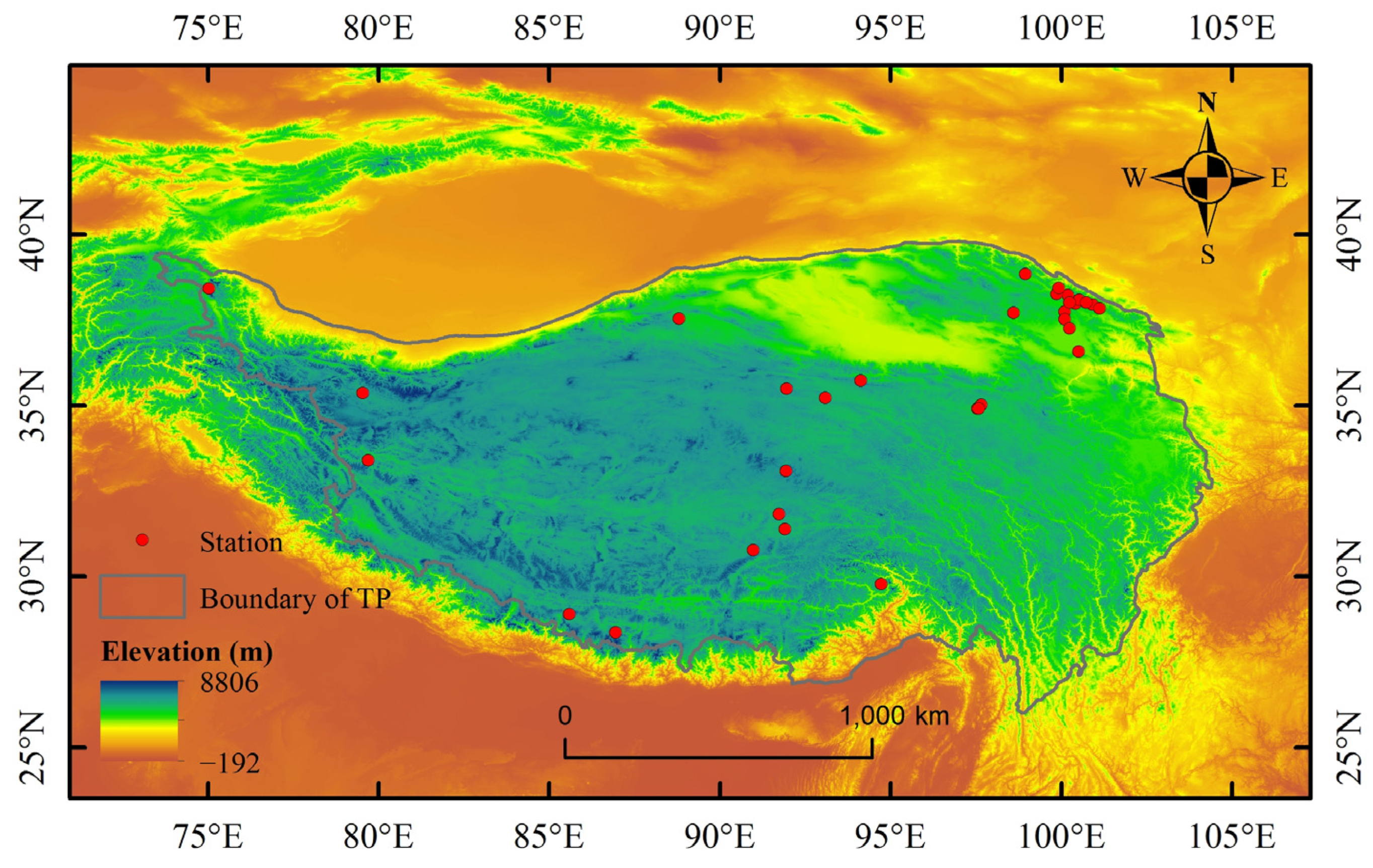
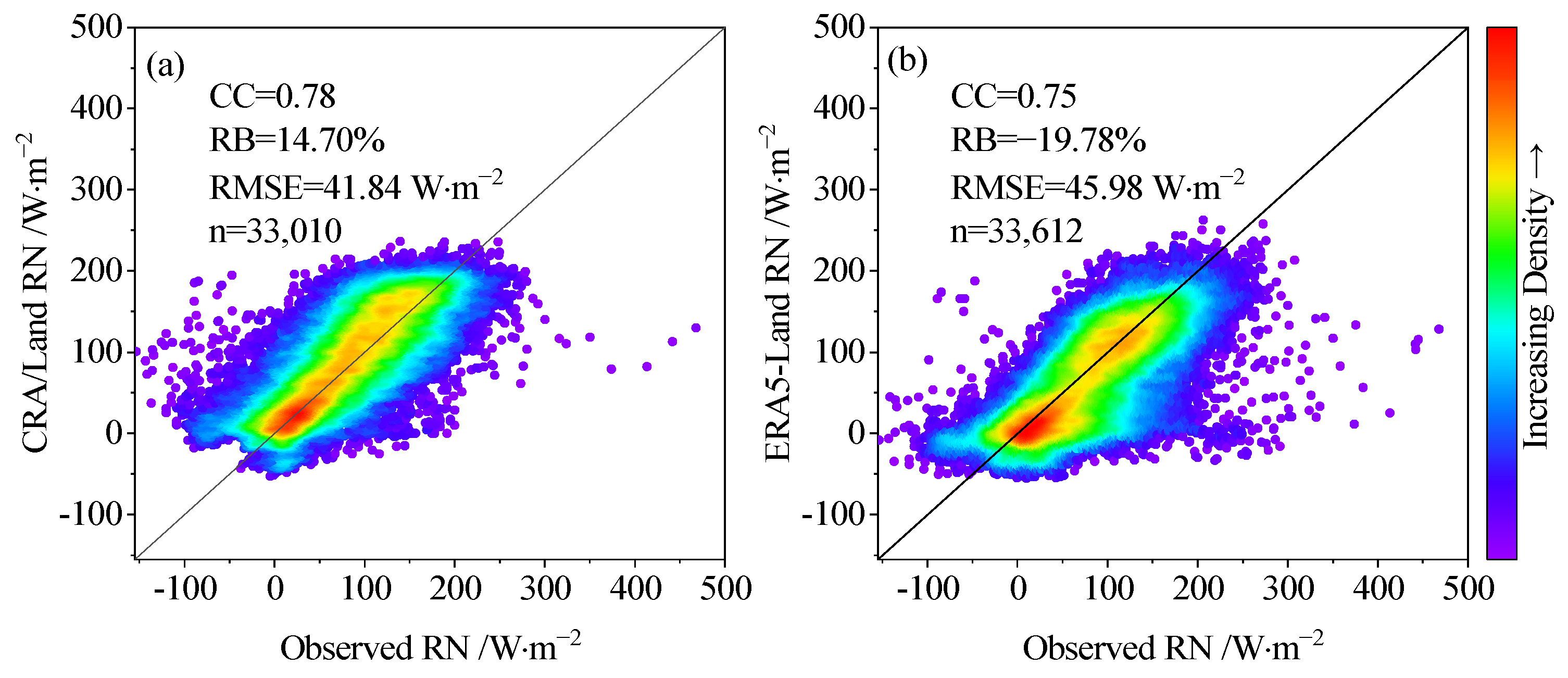
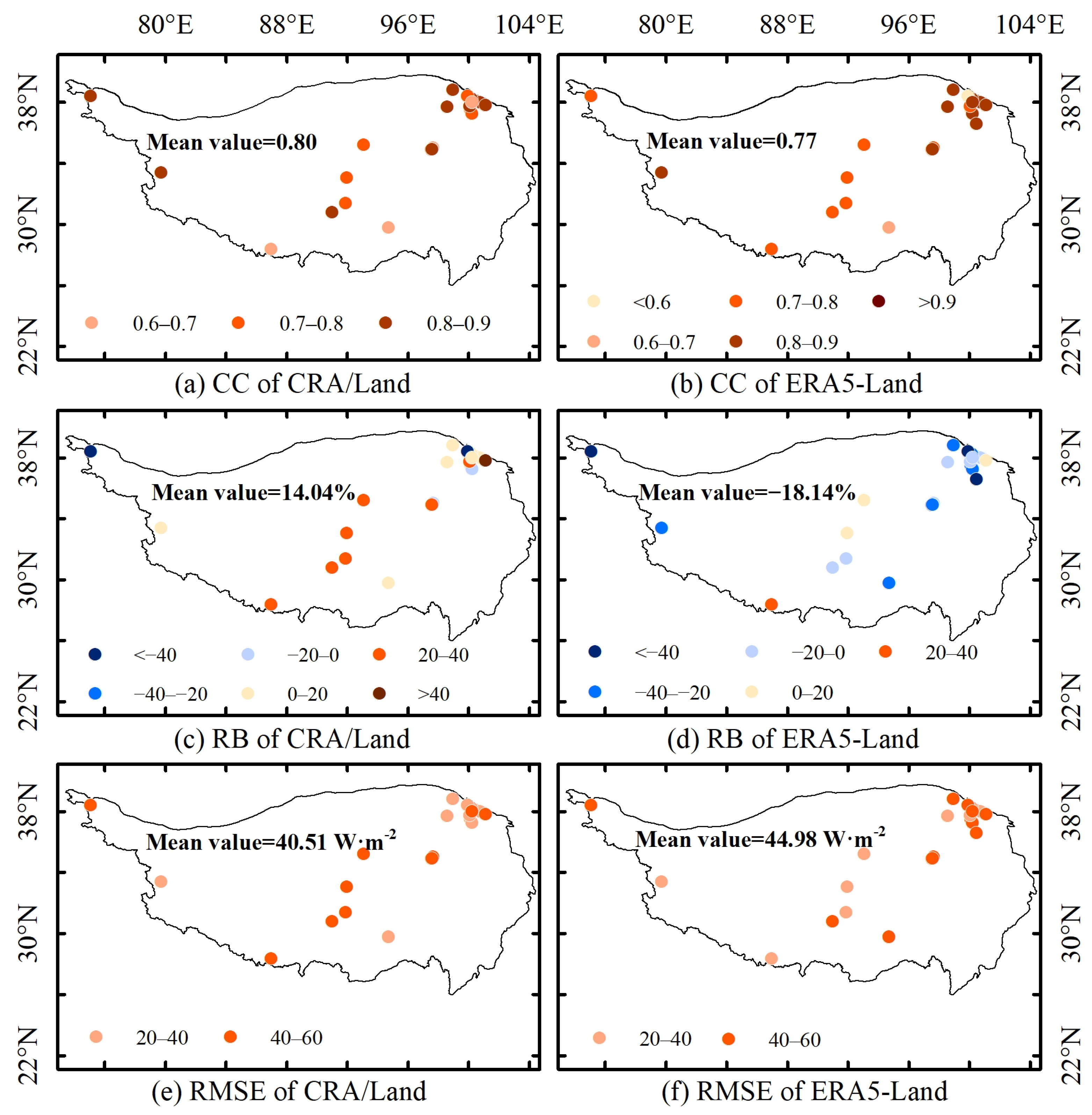
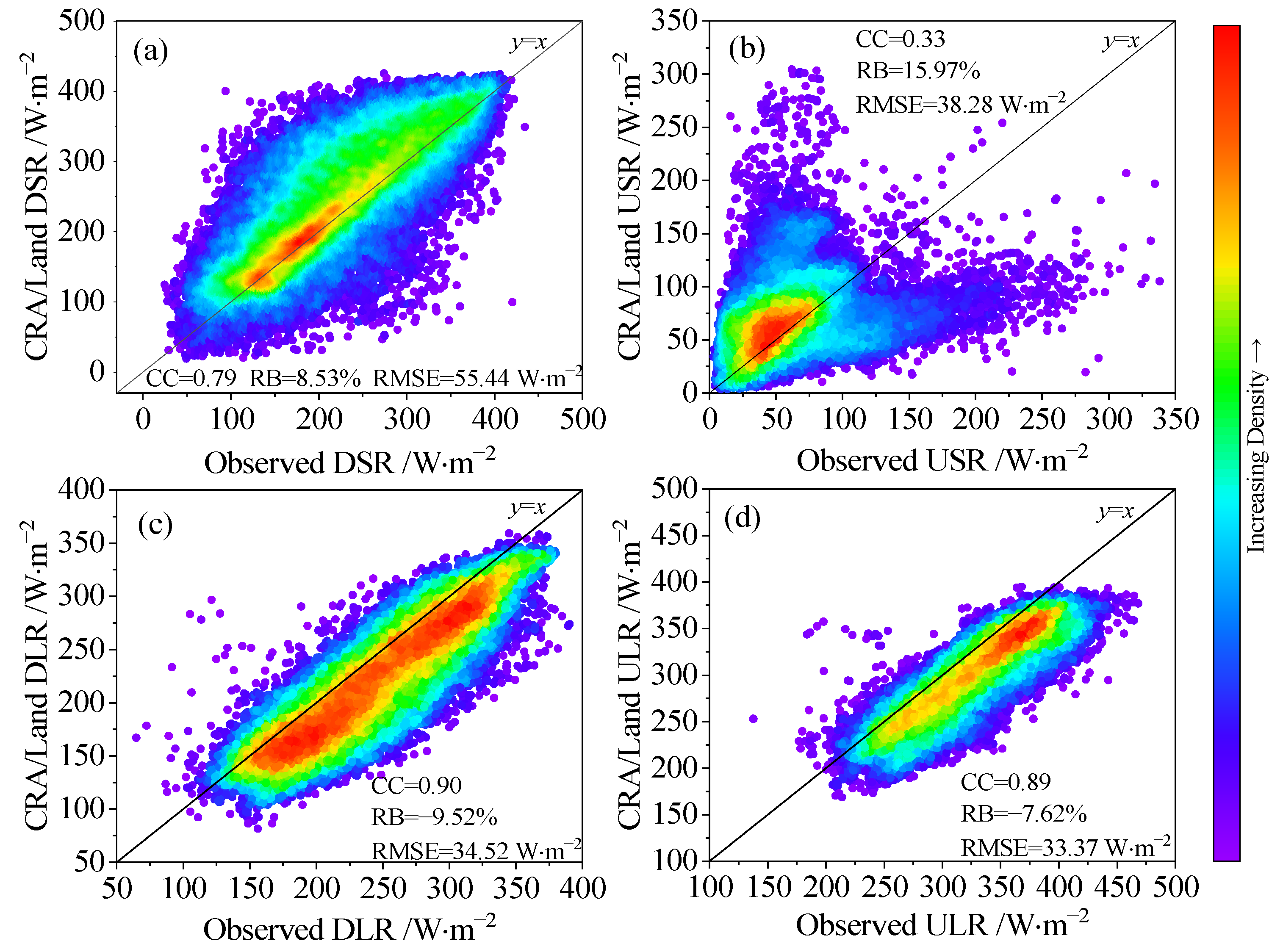
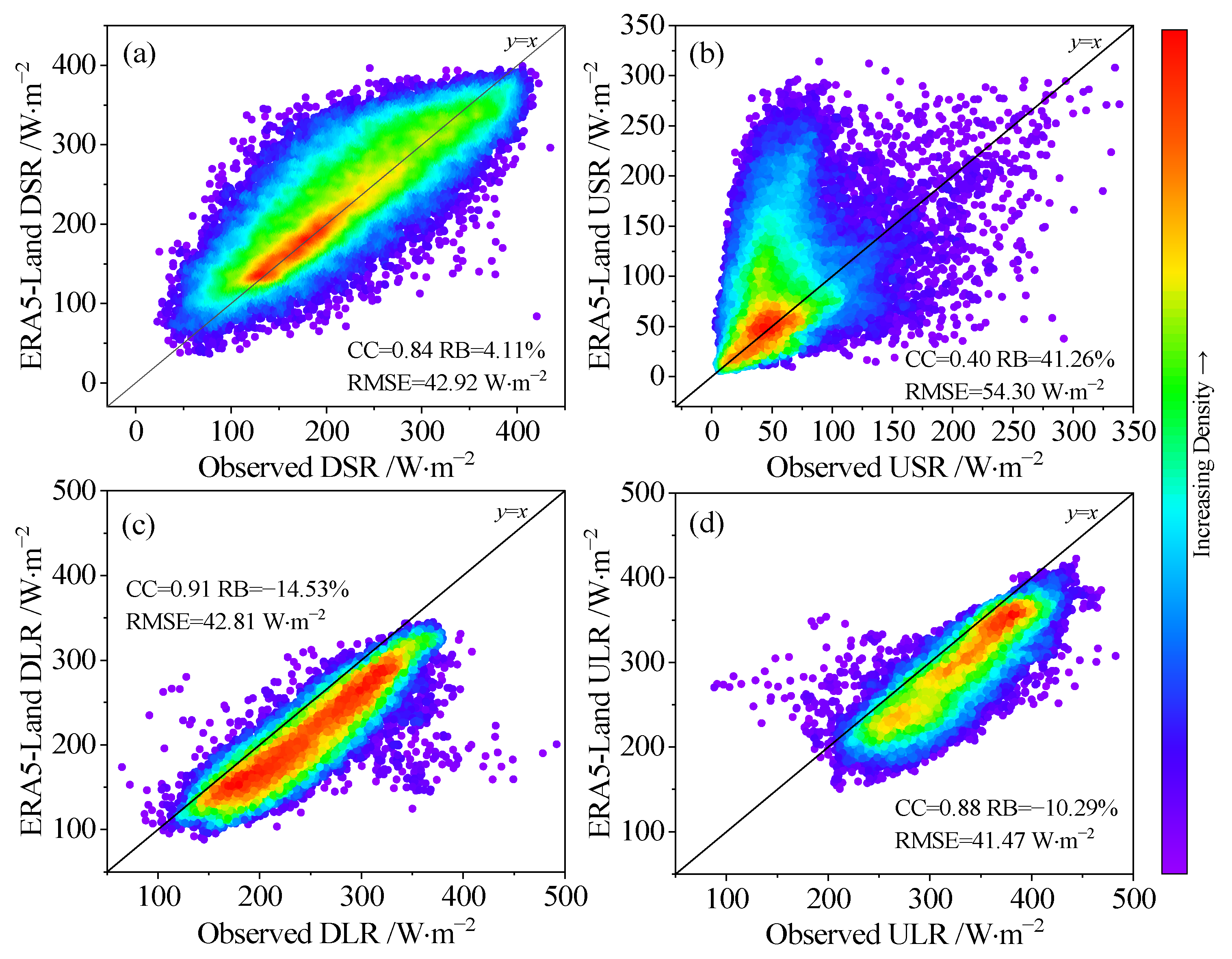
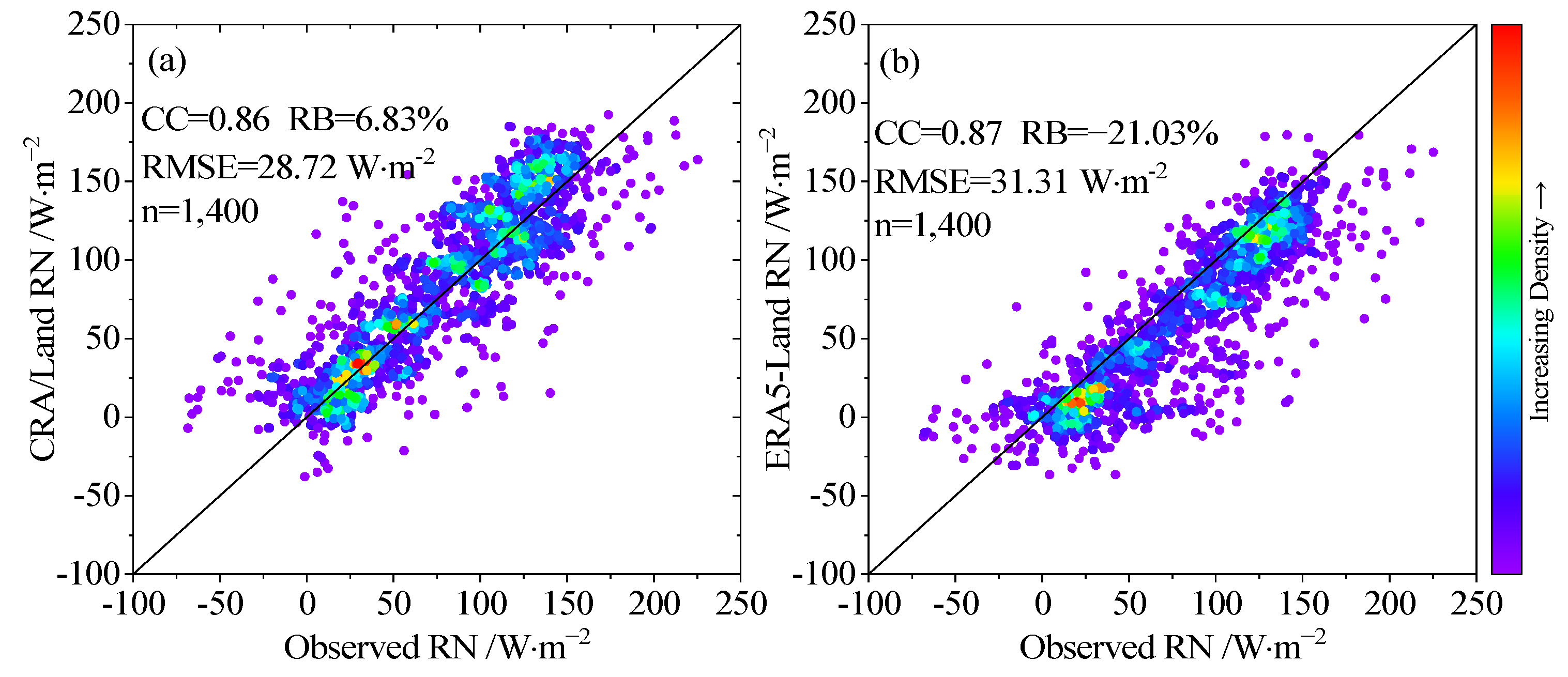
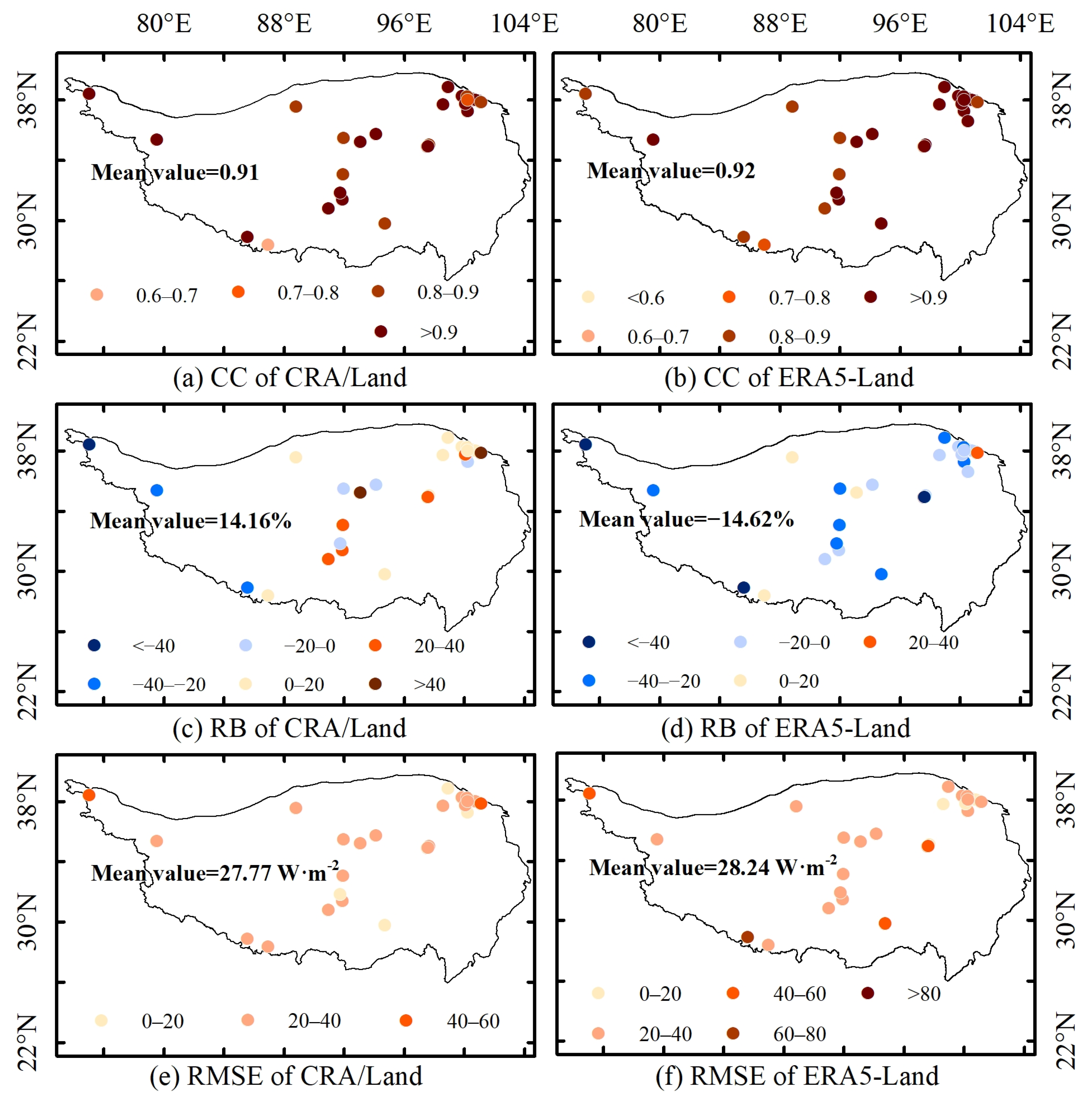

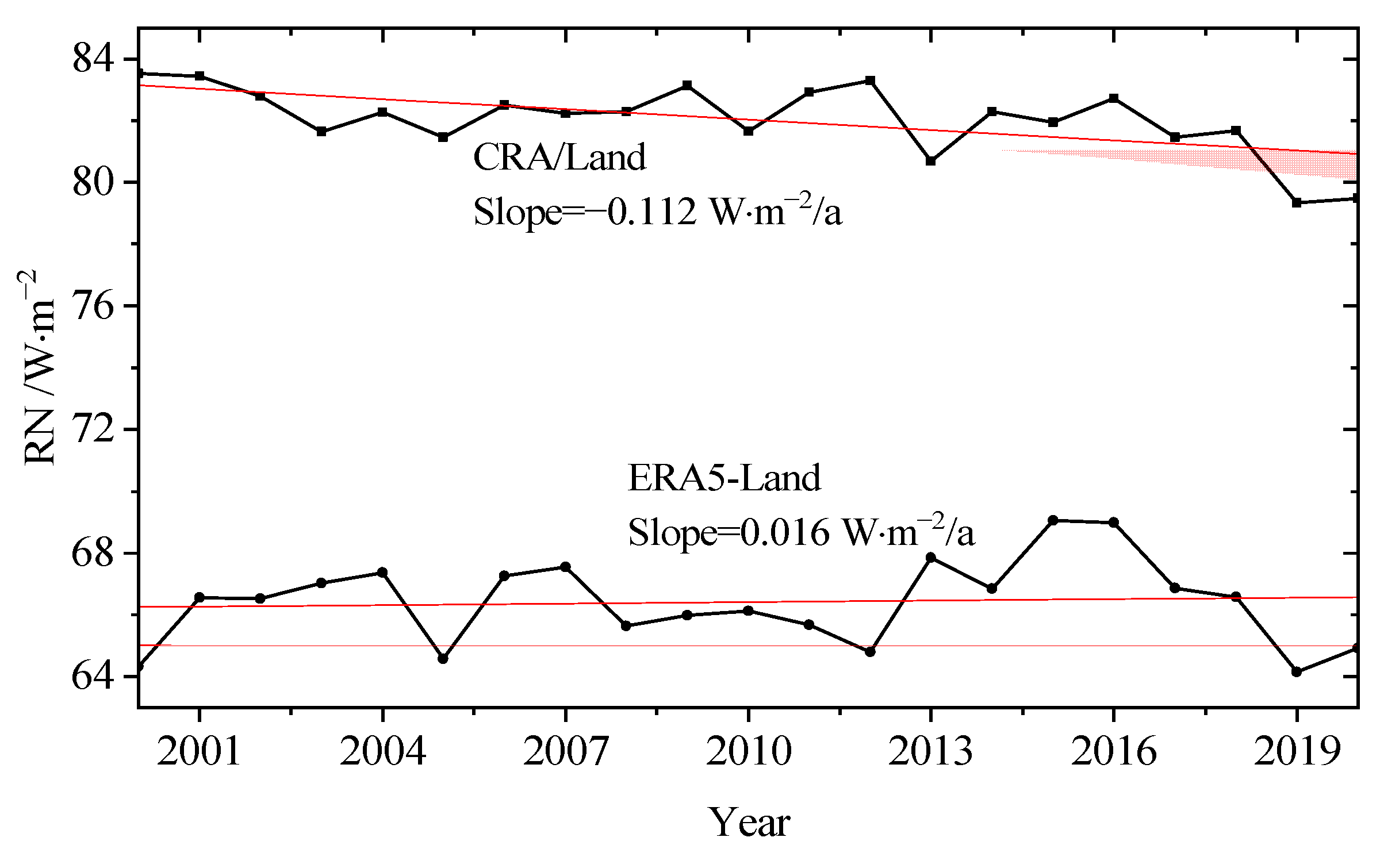
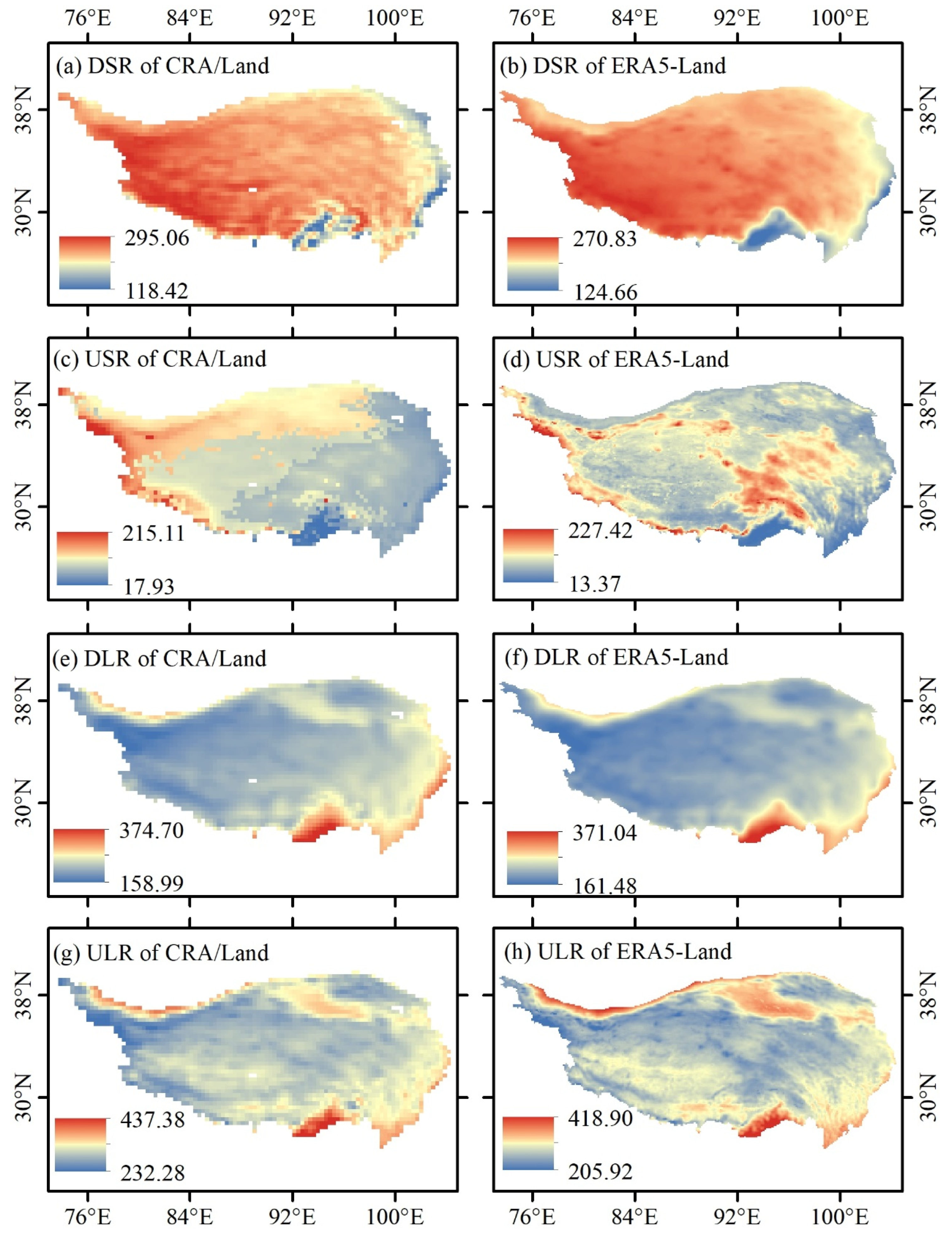

| Station | Longitude (°E) | Latitude (°N) | Elevation (m) | Land Cover | Time Interval | Periods |
|---|---|---|---|---|---|---|
| Wayanshan | 100.09 | 37.74 | 3700 | Alpine wet meadow | 30 min | 2017–2019 |
| Wudaoliang | 93.08 | 35.22 | 4783 | Alpine desert | 30 min | 2009–2014 |
| Xidatan | 94.13 | 35.72 | 4538 | Alpine meadow | daily | 2004–2018 |
| Tanggula | 91.94 | 33.07 | 5100 | Alpine meadow | daily | 2004–2018 |
| Liangdaohe | 91.74 | 31.82 | 4808 | Alpine wet meadow | daily | 2014–2018 |
| Zhuonaihu | 91.96 | 35.49 | 4784 | Alpine desert | daily | 2013–2018 |
| Ayakehu | 88.8 | 37.54 | 4300 | Alpine desert | daily | 2013–2018 |
| Tianshuihai | 79.55 | 35.36 | 4844 | Alpine desert | daily | 2013–2018 |
| BJ site of Nagqu Station of Plateau Climate and Environment | 91.9 | 31.37 | 4509 | Alpine meadow | 10 min | 2006–2016 |
| Qomolangma Atmospheric and Environmental Observation and Research Station | 86.95 | 28.36 | 4298 | Alpine desert | 1 h | 2006–2016 |
| Southeast Tibet Observation and Research Station for the Alpine Environment | 94.73 | 29.77 | 3327 | Alpine meadow | 1 h | 2008–2016 |
| Ngari Desert Observation and Research Station | 79.7 | 33.39 | 4270 | Alpine desert | 1 h | 2009–2016 |
| Muztagh Ata Westerly Observation and Research Station | 75.05 | 38.41 | 3668 | Alpine desert | 1 h | 2010–2016 |
| Nam Co Monitoring and Research Station for Multisphere Interactions | 90.98 | 30.77 | 4730 | Alpine steppe | 1 h | 2005–2016 |
| Qinghai Lake subalpine shrub station | 100.1 | 37.52 | 3495 | Shrub | 10 min | 2019–2020 |
| Qinghai Lake warm grassland station | 100.24 | 37.25 | 3210 | Alpine steppe | 10 min | 2019–2020 |
| Qinghai Lake alpine meadow grassland hybrid super station | 98.6 | 37.7 | 3718 | Alpine meadow and steppe | 10 min | 2018–2020 |
| Qinghai Lake Station | 100.5 | 36.58 | 3209 | Lake | 10 min | 2018–2019 |
| A’rou freeze-thaw station | 100.46 | 38.05 | 3033 | Alpine steppe | 30 min | 2007–2017 |
| A’rou north-facing station | 100.41 | 37.98 | 3536 | Alpine steppe | 30 min | 2013–2014 |
| A’rou south-facing station | 100.52 | 38.09 | 3529 | Alpine steppe | 30 min | 2013–2014 |
| Dashalong | 98.94 | 38.84 | 3739 | Alpine meadow | 30 min | 2013–2017 |
| E’bao | 100.92 | 37.95 | 3294 | Alpine steppe | 30 min | 2013–2016 |
| Huangcaogou | 100.73 | 38 | 3137 | Alpine steppe | 30 min | 2013–2015 |
| Huangzangsi | 100.19 | 38.23 | 2612 | Farmland | 30 min | 2013–2015 |
| Jingyangling | 101.12 | 37.84 | 3750 | Alpine meadow | 30 min | 2013–2017 |
| Yakou snow station | 100.24 | 38.01 | 4148 | Tundra | 30 min | 2014–2017 |
| Hulugou | 99.87 | 38.25 | 3232 | Shrub | daily | 2012–2013 |
| Grassland Observation Site in the Eling Lake Basin | 97.55 | 34.91 | 4280 | Alpine steppe | 30 min | 2012–2019 |
| Eling Lake Observation Site | 97.65 | 35.02 | 4274 | Lake | 30 min | 2012–2013 |
| Eling Lake Observation Site | 97.57 | 34.91 | 4275 | Lake | 30 min | 2013–2019 |
| Sidalong | 99.93 | 38.43 | 3146 | Forest | 10 min | 2018 |
| Peicuokuhu | 85.59 | 28.89 | 4590 | Lake | daily | 2015–2018 |
Disclaimer/Publisher’s Note: The statements, opinions and data contained in all publications are solely those of the individual author(s) and contributor(s) and not of MDPI and/or the editor(s). MDPI and/or the editor(s) disclaim responsibility for any injury to people or property resulting from any ideas, methods, instructions or products referred to in the content. |
© 2023 by the authors. Licensee MDPI, Basel, Switzerland. This article is an open access article distributed under the terms and conditions of the Creative Commons Attribution (CC BY) license (https://creativecommons.org/licenses/by/4.0/).
Share and Cite
Gao, L.; Zhang, Y.; Zhang, L. Validation and Spatiotemporal Analysis of Surface Net Radiation from CRA/Land and ERA5-Land over the Tibetan Plateau. Atmosphere 2023, 14, 1542. https://doi.org/10.3390/atmos14101542
Gao L, Zhang Y, Zhang L. Validation and Spatiotemporal Analysis of Surface Net Radiation from CRA/Land and ERA5-Land over the Tibetan Plateau. Atmosphere. 2023; 14(10):1542. https://doi.org/10.3390/atmos14101542
Chicago/Turabian StyleGao, Limimg, Yaonan Zhang, and Lele Zhang. 2023. "Validation and Spatiotemporal Analysis of Surface Net Radiation from CRA/Land and ERA5-Land over the Tibetan Plateau" Atmosphere 14, no. 10: 1542. https://doi.org/10.3390/atmos14101542
APA StyleGao, L., Zhang, Y., & Zhang, L. (2023). Validation and Spatiotemporal Analysis of Surface Net Radiation from CRA/Land and ERA5-Land over the Tibetan Plateau. Atmosphere, 14(10), 1542. https://doi.org/10.3390/atmos14101542






